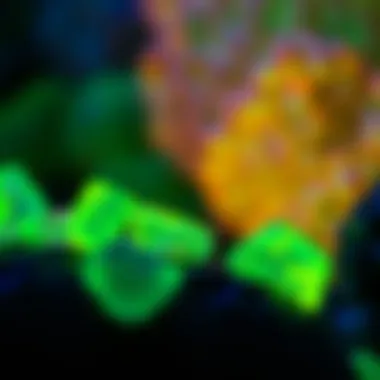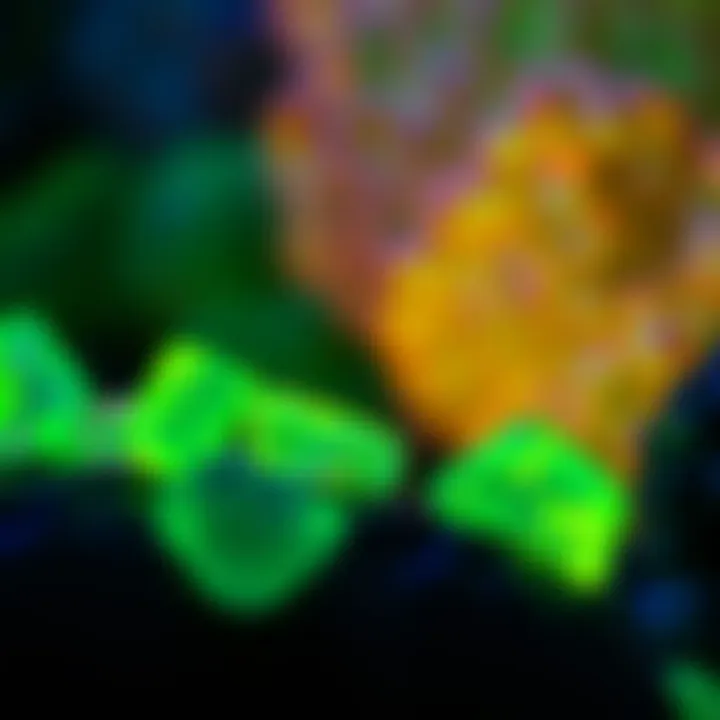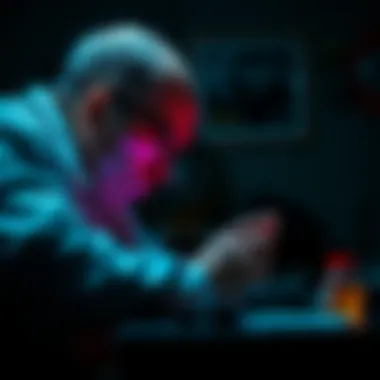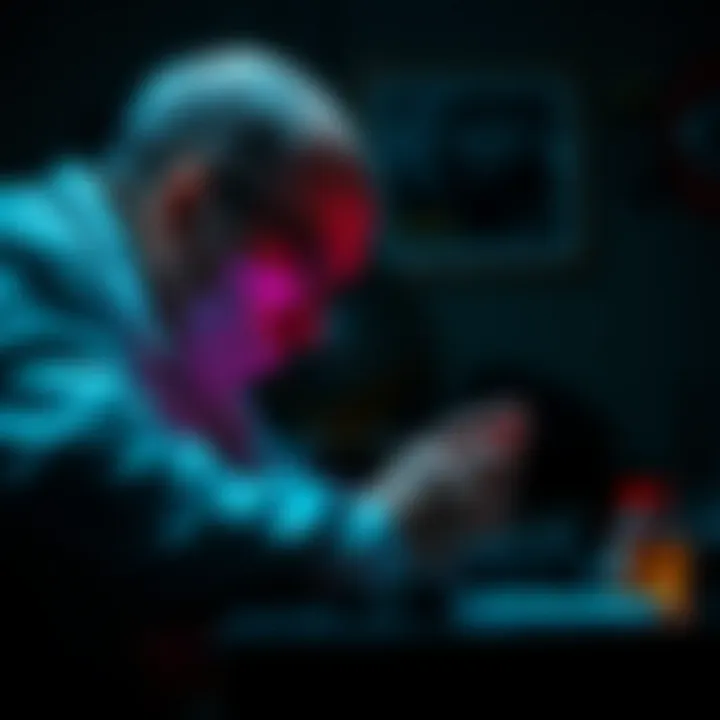Exploring the Science and Uses of Black Light


Intro
Black light, often referred to as ultraviolet light or UV light, occupies a distinctive niche in the spectrum of electromagnetic radiation. It greets us with its unique ability to reveal things ordinarily hidden from plain view. This hidden jewel not only illuminates vibrant fluorescence but plays a vital role in various practical applications spanning from the realms of art and forensic science to entertainment.
In the following sections, we will embark on a journey through the characteristics of black light, explore historical contexts, assess its various applications, especially in forensic science and art restoration, and provide guidance on its safe handling. The intriguing world of black light beckons you to explore, engage, and understand more about this fascinating segment of the light spectrum.
Foreword to Black Light
Defining Black Light
Black light refers to a type of ultraviolet (UV) light that is not visible to the naked eye but has a significant role in revealing properties and patterns that are otherwise elusive. The term encompasses a specific range of wavelengths, typically between 320 to 400 nanometers. When certain materials are exposed to black light, they exhibit fluorescence, emitting visible light. For rock collectors, this phenomenon can bring out the brilliance of certain minerals, allowing for a deeper appreciation of their collections.
In practical terms, black light is produced using specialized bulbs, either fluorescent or LED, which emit UV radiation. The effects of black light are diverse; for instance, certain minerals glow under its rays, while others may appear dull. This effect is essential for identifying not just the features of a specimen but also its authenticity, a critical aspect for collectors.
Historical Perspectives
The fascination with black light is not a modern occurrence; its history can be traced back to the late 19th and early 20th centuries. Early scientists, including the likes of William Herschel, were instrumental in discovering infrared and UV radiation. However, it wasn’t until the 1930s that black light gained widespread recognition.
Initially utilized for artistic purposes, it became increasingly important in scientific and industrial applications. During World War II, black light was employed for detecting counterfeit currency and in various military technologies. Over the decades, black light shifted towards entertainment, notably in concerts and art displays.
For rock and fossil collectors, understanding the historical context of black light is invaluable. Knowledge of how artists and scientists have used this technology can enhance the appreciation of a collection. Moreover, recognizing that many of the methods used today are rooted in historical practices can provide a richer narrative about each piece in a collection.
The Science Behind Black Light
Understanding the science behind black light is crucial for several reasons, especially for those in fields like art restoration, forensic science, and even environmental studies. The knowledge gleaned from this section equips readers with a holistic view of how black light interacts with different materials, its potential applications, and the science that allows us to utilize this fascinating segment of the electromagnetic spectrum.
Understanding the Electromagnetic Spectrum
The electromagnetic spectrum encompasses a range of wavelengths that describe all forms of light. At one end, you have radio waves, cruising along like unwelcome guests at a party. But as you move to shorter wavelengths, you encounter visible light — the rainbow we see. Just beyond that lies ultraviolet (UV) light, which, despite being invisible to the human eye, has significant effects on the world around us.
UV light can be categorized into three distinct types:
- UVA: The least energetic, often associated with skin aging.
- UVB: Responsible for sunburn, containing higher energy levels.
- UVC: The most energetic, but thankfully, it is largely absorbed by the Earth’s ozone layer, protecting us from its harmful effects.
Black light typically emits UVA rays. It’s widely used in various applications due to its ability to make certain materials and pigments glow brilliantly under its glow. This illumination can be quite striking both for scientific purposes and artistic visualizations.
Properties of Ultraviolet Light
Ultraviolet light holds unique properties setting it apart from visible light. The key characteristics involve its wavelength, energy levels, and its ability to affect different materials. One interesting aspect of UV light is its capacity to induce fluorescence. When a substance absorbs UV light, it can re-emit that energy as visible light, a phenomenon seen prominently in certain minerals and pigments.
Consider the following noteworthy points about UV light:


- Invisible Illumination: Human eyes can't see UV light, but many materials respond visibly when exposed.
- Energy Transfer: UV light can transfer energy to atoms, which sometimes leads to chemical reactions.
- Material Interaction: Different materials respond to UV light in unique ways, which can help in identifying substances in forensic investigations.
This captivating interplay is not just for show; it plays a vital role in art restoration and detecting counterfeits. With finer details becoming visible under black light, it helps art collectors and restorers make informed decisions.
How Black Light Works
At its core, black light operates by emitting ultraviolet radiation that usually falls within the UVA range. Black light fixtures use specific types of bulbs, such as fluorescent black lights, which fluoresce by converting some of the electrical energy into UV light. When materials absorb this UV radiation, they can emit visible light through fluorescence.
To understand the mechanics better, consider how black light works:
- Energy Emission: The black light contains special phosphor coatings that emit UV light when electricity is applied.
- Fluorescence Activation: When suitable materials come into contact with this UV light, they absorb it, which can lead to temporary luminescence.
- Applications in Reality: From exposing fingerprints in investigations to enhancing the colors of paints in art, black light truly transforms our perception of reality.
"Black light reveals not just the hidden, but also tells stories that are invisible to the naked eye."
For further reading, you can explore resources at Wikipedia on UV Light and Encyclopedia Britannica.
Applications of Black Light
Black light, though often viewed through a narrow lens of entertainment or novelty, holds substantial significance in various fields. Its unique properties, particularly the ability to reveal hidden details and influence material behavior, make it a crucial tool in sectors ranging from forensic science to health diagnostics. Understanding these applications can help enthusiasts, particularly rock and fossil collectors, appreciate the depth and versatility of black light in enriching their experiences and insights.
In Forensic Science
The use of black light in forensic science is nothing short of revolutionary. When investigating crime scenes, ultraviolet light aids in detecting substances that are often invisible to the naked eye. Blood, bodily fluids, and certain chemicals can fluoresce under black light, providing vital clues for investigators. For instance, a detective might sweep a crime scene with a black light, unveiling traces of a crime previously undetectable—like footprints left in blood or spilt substances from a struggle.
"In forensic contexts, the significance of black light transcends simple visibility; it can be the difference between solvable cases and cold files."
Beyond fluids, black light can also reveal alterations to documents or counterfeit currency, enhancing the investigative toolkit. Many forensic labs maintain black light systems as standard equipment, reflecting its importance in comprehensive evidence analysis.
Art and Artifact Restoration
The art world, including museums and antique dealers, also finds substantial value in black light for restoration purposes. Many pigments and materials used in artwork may not react visibly under regular light, making black light an invaluable resource for conservators. By using it, restorers can assess the integrity of paints and materials, uncovering areas that need attention without damaging the piece.
For rock and fossil collectors, black light can shed light on unique mineral fluorescence, revealing colors and dimensions that aren't apparent under typical lighting. This is particularly useful when evaluating rare specimens for authenticity and condition, allowing collectors to better ascertain their value and preservation needs.
Special Effects in Entertainment
Over the years, black light has infiltrated the entertainment industry, particularly in theater and clubs. Lighting designers use it to create surreal atmospheres or enhance visual presentations. Special effects can be amplified by incorporating fluorescent elements, providing a striking visual that engages audiences.
In addition to stagecraft, it has made its way into art installations and immersive experiences. For instance, a simple room can transform into a mesmerizing display by using fluorescent paints under black light, captivating visitors in a unique way.
Health and Safety Diagnostics


Health and safety professionals leverage black light to diagnose conditions that go beyond the skin's surface. Certain skin ailments—like fungal infections—can react under ultraviolet light, thus assisting medical professionals in identifying issues quickly. Awareness and examination of products, like sunscreens or lotions, also benefit from black light, as it can identify if products properly absorb UV radiation—a critical check for healthy skin practices.
*
Learn more about the applications of black light in these resources: Wikipedia, Britannica and explore discussions on Reddit.
The Impact of Black Light on Materials
The interaction of black light with various materials is not just an interesting side note; it forms a foundational aspect of its applications in many fields. Understanding how different materials respond to black light helps in harnessing its potential effectively, whether it’s in art, science, or safety measures. Specifically, this section highlights the variations in reactions from fluorescent and non-fluorescent materials, shedding light on critical insights that can enhance practices in sectors like forensic science and restoration.
Fluorescent Materials
Fluorescent materials possess the fascinating ability to absorb black light and re-emit it at a longer wavelength, usually visible as bright colors. This phenomenon stems from their unique molecular structure that allows them to trap energy and release it in a visible spectrum. In simplified terms, when these materials are bathed in black light, they almost seem to come alive, glowing in vibrant hues. This happens in various substances, including paints, certain types of rocks, and biological materials. Here’s why their responsiveness to black light is significant:
- Identification and Analysis: Fluorescence can be crucial in forensic science. Crime scene investigators often utilize black light to reveal evidence invisible to the naked eye. Various substances, like bodily fluids or certain fibers, fluoresce under UV light, providing clues about a crime scene.
- Art Restoration: In the realm of art, restorers employ black light to assess the condition of paintings and artifacts. It helps them to identify previous restoration work or hidden damages that require attention.
- Rock and Mineral Collecting: Collectors often seek out minerals like fluorite or calcite, which exhibit striking fluorescence. This property not only adds aesthetic value but also enhances the collector's ability to distinguish genuine specimens from imitations.
Understanding the behavior of fluorescent materials can lead to better practices across various fields, making it clear that knowing how these substances react is akin to holding a key that unlocks hidden knowledge.
Non-Fluorescent Materials
In contrast, non-fluorescent materials do not exhibit the same glowing characteristics when exposed to black light. This does not mean they lack importance; rather, it underscores an essential aspect of black light’s impact. Exploring how these materials interact reveals vital insights:
- Understanding Limitations: Many traditional materials, including several gemstones and rocks, may not respond to black light. This distinction helps collectors and scientists set expectations when analyzing samples. Knowing what doesn’t fluoresce is just as important as knowing what does; it equips collectors and researchers with a more comprehensive understanding of their specimens.
- Analysis Techniques: Even though non-fluorescent materials may not glow, black light can still aid in analysis. For example, examining mineral surfaces under UV rays may reveal surface imperfections or help differentiate among different types of inclusions, enhancing the overall characterization of samples.
- The Broader Picture: Understanding both fluorescent and non-fluorescent materials offers a balanced view of how light interacts with the physical world. It sets the stage for advancements in areas like UV protection in art conservation or non-invasive testing in geology.
Selecting materials wisely can lead to groundbreaking discoveries. The true value of black light is not just in what it reveals, but also in what remains hidden, guiding us toward deeper understanding.
Safety Considerations
Safety concerns surrounding the use of black light are paramount. Whether used in forensic settings, art restoration, or recreational activities, understanding and mitigating the risks associated with ultraviolet (UV) exposure is essential. This section delves into the potential dangers posed by black light and outlines best practices for ensuring safe use.
Potential Risks of UV Exposure
UV exposure can lead to various health issues, and understanding these risks is fundamental for anyone working with black light. Here’s what to keep in mind:
- Skin Damage: Prolonged exposure to UV light can cause skin burns and increase the risk of skin cancer. This applies not only to professionals in the field but also to hobbyists who might be careless during short, experimental uses.
- Eye Injury: Black light can significantly harm the eyes. It may cause temporary visual disturbances like flashes and even long-term damage, including cataracts.
- Photosensitivity: Some individuals may have heightened sensitivity to UV light, resulting in allergic reactions or heightened skin responses, which emphasizes the need for caution when working in teams or with diverse groups.
"Limited exposure is key to ensuring a safe interaction with UV light sources."
Aside from these health risks, the interaction of UV light with certain materials can lead to unexpected results, such as the breakdown of pigments or alterations in the structural integrity of specimens, relevant for rock and fossil collectors. The importance of protective measures cannot be overstated.
Best Practices for Safe Use


To create a safe working environment when using black light, consider the following best practices:
- Protective Gear: Always wear protective gear. This includes UV-blocking glasses specifically designed for this purpose, and long-sleeved clothing that covers the skin adequately. Sunscreen can also help protect exposed areas.
- Work in Moderation: Limit the duration of exposure to black light. Frequent breaks can prevent overexposure and diminish the accumulation of potential damage.
- Proper Ventilation: When utilizing black light in confined areas, ensure good airflow to reduce the build-up of harmful fumes which can be emitted from certain materials under UV exposure.
- Inform Others: If you are in an environment where black light is used, inform your colleagues or friends of the risks involved. This proactive approach can enhance safety and create a better environment for everyone.
- Choose Equipment Wisely: Use high-quality black light devices that have safety features and emit lower levels of harmful UV rays. Check user reviews and abide by manufacturer recommendations.
By actively following these guidelines, individuals can harness the unique properties of black light without compromising their health or safety. Recognizing the potential dangers and implementing measures to address them truly marks responsible use of this fascinating yet powerful tool.
Future Research Trends
Black light serves as a fascinating subject of inquiry, particularly as science and technology continue to evolve. This section delves into the significance of future research trends within this engaging field.
Here are some key considerations that drive future research in black light technology:
- Innovation in UV Technology: Modern advancements in ultraviolet technology are opening doors to better tools for black light applications. Enhanced UV LED technology, for instance, promises longer lifespans and decreased energy consumption. This progress can minimize costs and amplify efficiency in refining techniques used in a plethora of sectors.
- Interdisciplinary Research Collaborations: Combining disciplines such as physics, chemistry, and biology can inject fresh perspectives into black light research. By fostering collaboration among different scientific fields, researchers can generate novel ideas, potentially leading to groundbreaking discoveries.
- Safety Protocol Development: As new technologies emerge, understanding their impact on human health becomes crucial. Future research must prioritize the establishment of safety standards to mitigate any risks associated with ultraviolet exposure in various settings.
This focus on future advancements not only encourages innovation but also ensures the responsible use of black light across different applications. The exploration of these advancements is not just for the academic elite; rather, it's an invitation to engage a wider audience in meaningful discussions that can shape the future of technology.
Advancements in UV Technology
Recent developments in ultraviolet technology have turned heads in more ways than one. For starters, the transition from traditional mercury vapor lamps to ultraviolet LEDs represents a considerable leap forward. UV LEDs are lighter, more compact, and can be tailored to emit a specific wavelength. This flexibility is crucial for precise applications such as detecting minerals in rock and fossil collections.
Moreover, the decreased heat emissions from LEDs allow for safer handling in theatrical and forensic environments. As UV LEDs become more affordable, everyday consumers might see them in various applications from home decoration to educational tools.
For example, scientists have begun utilizing specialized UV LEDs to enhance photodynamic therapy methods capable of treating certain cancers. As research deepens into how specific wavelengths interact with various biological tissues, the implications could result in far-reaching advancements in medical science.
Exploring New Applications
The vast potential of black light technology paves the way for discovering innovative applications. One particularly intriguing development is its application in environmental monitoring. For rock and fossil collectors, black light can uncover fluorescent minerals that are otherwise not visible under normal lighting conditions. This can enrich knowledge and enthusiasm for geology and paleontology.
Potential New Applications Include:
- Detecting Counterfeit Materials: Fraudulent items can sometimes be revealed through the use of black light, shedding light on inconsistencies that aren't visible to the naked eye.
- Enhanced Art Conservation: Continued research can lead to improved methodologies in art conservation. Evaluating how various pigments react to black light could assist restorers in making informed decisions about the preservation of artworks.
- Health Diagnostics: Studying the influence of ultraviolet exposure on various conditions could lead to enhanced diagnostic equipment, providing insights into ailments not currently detectable through conventional means.
In sum, the future of black light research holds immense promise. As new technologies unfold and innovative applications emerge, the realm of possibilities stretches infinitely, ensuring an ever-evolving engagement with this unique spectrum of light.
Culmination
In wrapping up our discourse on black light, it is critical to underscore its multifaceted applications and significance across various realms. Black light goes beyond mere aesthetics; it serves as a vital tool in forensic science, art preservation, and even health diagnostics. With its unique ability to reveal properties of materials that are invisible to the naked eye, black light has carved out a niche in the toolkit of professionals and enthusiasts alike. Understanding its workings and effects not only illuminates the abstract qualities of this light but also invites a deeper appreciation of its role in both scientific exploration and artistic expression.
Summary of Black Light Significance
The significance of black light rests on its capacity to interact with different substances. For instance, in forensic science, its use is pivotal in detecting bodily fluids that would otherwise remain hidden. This straightforward observation can be the linchpin for solving crimes and securing justice. Alongside forensic applications, black light is instrumental in the conservation of art, where it aids in identifying previous restorations or materials used in a piece. This duality of application demonstrates how black light acts as a bridge between science and art, fostering a cross-disciplinary dialogue that enriches both fields. Moreover, for rock and fossil collectors, this light provides an avenue to uncover peculiar characteristics in minerals or fossils, enhancing the overall collecting experience.
Closing Thoughts on its Future
Looking toward the future, the research trends surrounding black light hint at increased sophistication in its applications. Emerging technologies may amplify its capability to analyze materials at a deeper level. Future advancements could optimize the safety of UV technology while expanding its use in various sectors, from environmental monitoring to innovative art practices. As awareness grows about the implications of black light, both positive and negative, discussions surrounding safe practices will become even more pertinent. With science and technology continually evolving, the future of black light promises to not only shed light on the unseen but also to ensure that this fascinating aspect of the electromagnetic spectrum is harnessed responsibly.
The future of black light is compelling, urging us to adopt a balanced perspective on its use and potential ramifications.



